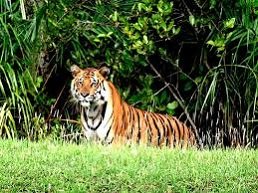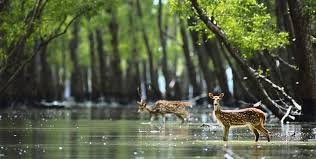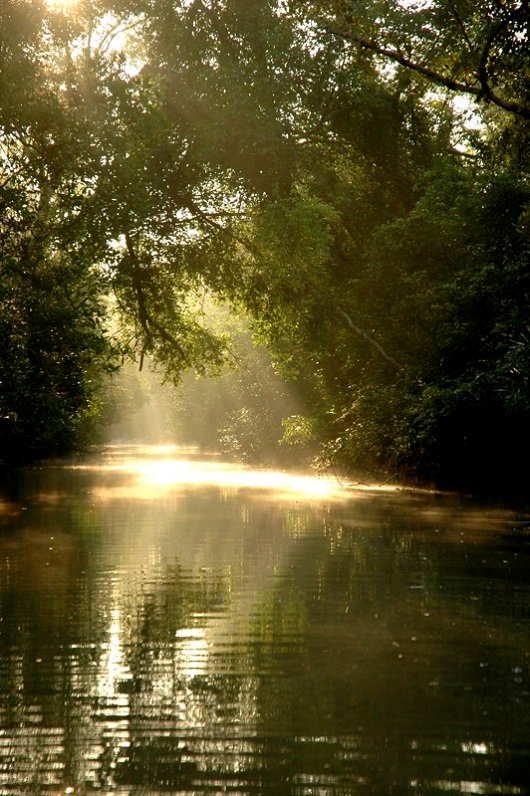Sundarban World largest mangrove forestGeneral Description
Sundarban is the biggest mangrove forest in the world. Sundarban is in South West part of Bangladesh, in the district of greater Khulna. India shares a bit of the forest with Bangladesh. The total area is about 38,000 square kilo meters. Sundarban is a large block of littoral forests. The beauty lies in its unique natural surrounding. The Sundarbans are a part of the world's largest delta formed by the rivers Ganges, Brahmaputra and Meghna. Thousands of meandering streams, creeks, rivers and estuaries have enhanced its charm. For miles and miles, the lofty treetops form an unbroken canopy, while nearer the ground, works of high and ebb-tide marked on the soil and tree trunks and the many varieties of the natural mangrove forest have much to offer to an inquisitive visitor.

Sundarban is the natural habitat of the world’s famous Royal Bengal Tiger, spotted deer, crocodiles, jungle fowl, wild boar, lizards and many more. Migratory flock of Siberian ducks flying over thousands of sail boats loaded with timber, Golpata, fuel wood, honey, shell and fish further add to the serene natural beauty of the Sundarban.
In general, the northern boundary and new depositions are characterized by Baen (Avicennia marina , A. alba, A. officinalis ) flanked by foreshore grassland of Oryza coarctata (Dhani grass). Baen is gradually replaced by Gewa (Excoecaria agallocha) and then Goran (Ceriops spp.). The southern and eastern associates include Garjan (Rhizophora spp.), Kankra (Bruguiera spp.), and few patches of Sundari (Heritiera fomes) . Hental forest exists in relatively high land and compact soil. Dhundul
, Passur (Xylocarpus mekongensis) and Nipa fruticans (Golpata) palm swamps are extremely limited.
The Sundarban Reserved Forest (SRF), occupying an area of around 6,017 square kilometres or 600,000 hectares, represents 51 percent of the total reserved forest area of Bangladesh and as such forms a rich and diverse ecosystem with potential for sustainable natural resource management. Man has exploited the Sundarban for centuries but the forest was not given Reserve status by the Forestry Department until 1875.

managed the forest and other natural resources of the SRF through adherence to management plans which it prepares at regular intervals.Early management simply concentrated on revenue collection and the enforcement of felling rules to reduce overcutting, particularly in the eastern portion. The first real professional forest management planning was introduced in the SRF in the early 1900s with the introduction of the Curtis Working Plan.
However, more recently forest resource management has shifted to increase emphasis upon environmental and socio-economic issues.
The following table presents the fractions represented by forest and other land types in the Sundarban.
Famous spots

The main tourist point is Hiron Point (Nilkamal) for watching tiger, deer, monkey, crocodiles, birds and natural beauty. Katka is for watching deer, tiger, crocodiles, varieties of birds and monkey. Morning and evening symphony of wild fowls. Vast expanse of grassy meadows running from Katka to Kachikhali (Tiger Point) provide opportunities for wild tracking. Tin Kona Island for tiger and deer. Dublar Char (Island) for fishermen. It is a beautiful island where herds of spotted deer are often seen to graze. Here land and water meet in many novel fashions, Wildlife presents many a spectacle. No wonder, you may come across a Royal Bengal Tiger swimming across the streams or the crocodiles basking on the river banks. With the approach of the evening herds of deer make for the darkling glades where boisterous monkeys shower Keora leaves from above for sumptuous meal for the former. For the botanist, the love of nature, the poet and the painter this land provides a variety of wonder for which they all crave.
Good...??? My Follow me please my Upvotes end Comment Follow please????